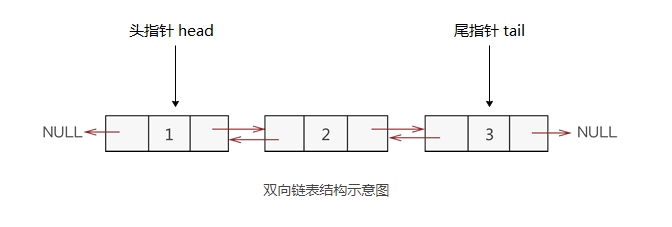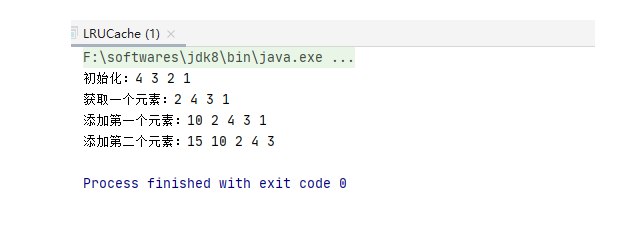LRU 原理与算法实现
- 2022 年 6 月 24 日
本文字数:10990 字
阅读完需:约 36 分钟
什么是 LRU
LRU(Least Recently Used,最近最少使用)算法是一种内存数据淘汰策略,当内存不足时,需要淘汰最近最少使用的数据。
其核心思想是长期不被使用的数据,在未来被使用到的几率也不大。因此,当数据所占内存达到一定阈值的时候需要淘汰掉这些数据。
LRU 原理
按照 LRU 的核心思想,不被使用的数据,在未来被使用到的几率也不大,那么当数据在最近一段时间经常被访问,那么它在以后也会经常被访问。这就意味着,如果经常访问的数据,我们需要然其能够快速命中,而不常访问的数据,我们在容量超出限制内,要将其淘汰。即:
当新数据插入到链表头部;
每当缓存命中(即缓存数据被访问),则将数据移到链表头部;
当链表满的时候,将链表尾部的数据丢弃。

LRU 的实现
常用的数据结构有很多,如数组、链表、栈、队列等等,这里演示 2 种做法,单链表和双向链表 + 哈希表实现。
为什么要先用单链表去实现?其目的是为了从简单到复杂的去了解 LRU 的设计过程。
当前,前提是你得了解单双链表的数据结构,不了解的可以参考:手写链表之 LinkedList 源码分析
单链表实现 LRU
既然要用单链表实现,首先得定义一个单链表,并且具备增删改查功能,如下:

1、先定义链表节点信息
/** * 节点信息 * * @param <E> */private static class Node<E> { // 元素 E item; // 后继节点(这里是单链表,只有一个后继节点) Node<E> next; public Node(E item, Node<E> next) { this.item = item; this.next = next; }}2、定义增删方法
/** * 在头部添加节点,一般来说是在尾部添加,但这里为了演示 LRU 所以从头添加元素 * * @param e */public void addFirst(E e) { Node<E> curNode = new Node<>(e, list); list = curNode; size++;}/** * 删除最后一个元素 */public void removeLast() { if (list != null) { // 当前节点 Node<E> cur = list; // 最后一个节点的前一个节点 Node<E> pre = list; // 判断当前节点是否是最后一个节点 while (cur.next != null) { pre = cur; cur = cur.next; } pre = null; size--; }}完整代码:
public class SingleLinkeList<E> { // 链表 Node<E> list; // 链表节点数量 int size; /** * 在头部添加节点,一般来说是在尾部添加,但这里为了演示 LRU 所以从头添加元素 * * @param e */ public void addFirst(E e) { Node<E> curNode = new Node<>(e, list); list = curNode; size++; } /** * 删除最后一个元素 */ public void removeLast() { if (list != null) { // 当前节点 Node<E> cur = list; // 最后一个节点的前一个节点 Node<E> pre = list; // 判断当前节点是否是最后一个节点 while (cur.next != null) { pre = cur; cur = cur.next; } pre = null; size--; } } /** * 检测index是否在链表范围以内 * * @param index */ public void checkPositionIndex(int index) { if (!(index >= 0 && index <= size)) { throw new IndexOutOfBoundsException("index: " + index + ", size: " + size); } } /** * 节点信息 * * @param <E> */ private static class Node<E> { // 元素 E item; // 后继节点(这里是单链表,只有一个后继节点) Node<E> next; public Node(E item, Node<E> next) { this.item = item; this.next = next; } } @Override public String toString() { Node node = list; for (int i = 0; i < size; i++) { System.out.print(node.item + " "); node = node.next; } System.out.println(); return super.toString(); }}注:以上只写了对 LRU 有用的新增和删除方法,单链表的查询和修改并没有添加。
单链表实现 LRU 缓存
1、定义内存限制
既然是缓存,内存大小肯定是存在限制的,因此我们要定义其内存大小,如下:
// 用于限定内存空间大小,也就是缓存的大小int size;// 默认容量,假设为 5static final int DEFAULT_CAP = 5;2、添加元素
在添加元素的时候我们需要考虑以下 2 点:
当链表满的时候,将链表尾部的数据丢弃;
新数据插入到链表头部。
/** * LRU 添加节点 * * @param e */public void lruAdd(E e) { // 如果链表的容量大于缓存容量,将链表尾部的数据丢弃 if (size > memory_size) { removeLast(); addFirst(e); } else { // 否则新数据插入到链表头部 addFirst(e); }}3、LRU 删除
对于删除元素,只需将链表的最后一个元素删除即可。
/** * 删除 */public void lruRemove() { removeLast();}4、LRU 访问
对于访问的数据,则将数据移到链表头部。
/** * 获取 */public E lruGet(int index) { // 检查是否在链表范围内 checkPositionIndex(index); // 目标节点,即 index 位置的节点 Node<E> cur = list; // 目标节点的前一个节点 Node<E> pre = list; // for 循环获取目标节点 for (int i = 0; i < index; i++) { pre = cur; cur = cur.next; } //获取目标元素 E item = cur.item; // 把目标节点的后继节点重新赋值给目标节点前置节点的后置节点 pre.next = cur.next; Node<E> head = list; // 然后把目标节点移动到头结点,即把剩下的节点当做目标节点的后继节点 cur.next = head; // 重新赋值给 list list = cur; return item;}完整代码:
/** * LRU 的3要素 * 1. 当新数据插入到链表头部 * 2. 每当缓存命中(即缓存数据被访问),则将数据移到链表头部 * 3. 当链表满的时候,将链表尾部的数据丢弃 */public class LRUCache<E> extends SingleLinkeList<E> { // 用于限定内存空间大小,也就是缓存的大小 int memory_size; // 默认容量,假设为 5 static final int DEFAULT_CAP = 5; public LRUCache() { this(DEFAULT_CAP); } public LRUCache(int memory_size) { this.memory_size = DEFAULT_CAP; } /** * LRU 添加节点 * * @param e */ public void lruAdd(E e) { // 如果链表的容量大于缓存容量,将链表尾部的数据丢弃 if (size > memory_size) { removeLast(); addFirst(e); } else { // 否则新数据插入到链表头部 addFirst(e); } } /** * 删除 */ public void lruRemove() { removeLast(); } /** * 获取 */ public E lruGet(int index) { // 检查是否在链表范围内 checkPositionIndex(index); // 目标节点,即 index 位置的节点 Node<E> cur = list; // 目标节点的前一个节点 Node<E> pre = list; // for 循环获取目标节点 for (int i = 0; i < index; i++) { pre = cur; cur = cur.next; } //获取目标元素 E item = cur.item; // 把目标节点的后继节点重新赋值给目标节点前置节点的后置节点 pre.next = cur.next; Node<E> head = list; // 然后把目标节点移动到头结点,即把剩下的节点当做目标节点的后继节点 cur.next = head; // 重新赋值给 list list = cur; return item; }}测试:
public static void main(String[] args) { LRUCache<Integer> lruCache = new LRUCache<>(5); // 初始化元素 for (int i = 1; i < 5; i++) { lruCache.lruAdd(i); } System.out.println("初始化元素"); lruCache.toString(); System.out.println("获取第 3 个位置的元素:" + lruCache.lruGet(3)); // 此时,应该把第 3 个位置的元素设置为头结点 lruCache.toString(); lruCache.lruAdd(10); System.out.println("新增第一个元素"); lruCache.toString(); lruCache.lruAdd(15); System.out.println("新增第二个元素"); lruCache.toString();}输出:
初始化元素4 3 2 1获取第 3 个位置的元素:11 4 3 2新增第一个元素10 1 4 3 2新增第二个元素15 10 1 4 3
双链表实现 LRU
除了单链表 JDK 中自带了双向链表的实现,即 LinkedList,但如果在面试的情况下,可能需要你实现一个简单的双向链表,而不是用现有的。
因此,我们按照单链表的实现方式来实现一个简单的双向链表,与单链表不同的是,节点有前驱和后继 2 个引用,如下:

节点构造如下:
class Node<E> { E item; Node<E> prev; Node<E> next; public Node(E item, Node<E> prev, Node<E> next) { this.item = item; this.prev = prev; this.next = next; }}然后构建一个新增头节点和删除尾结点的方法,参考 JDK 中的 LinkedList,如下:
public class LinkedList<E> { // 头结点 Node<E> head; // 尾结点 Node<E> tail; // 链表节点数量 int size; /** * 添加头结点 * * @param e */ public void addFirst(E e) { Node<E> f = head; // 新添加的元素作为新的头结点 Node<E> newNode = new Node<>(e, null, f); head = newNode; // 如果原头结点为 null,则说明原链表不存在数据,即空链表,因此头尾节点相等 if (f == null) { tail = newNode; } else { // 否则,将原头结点的前置指针指向新的节点 f.prev = newNode; } size++; } /** * 删除最后一个元素,参考 LinkedList */ public E removeLast() { // 1.这里要先判断链表是否为空,为空直接抛异常 final Node<E> h = head; if (h == null) { throw new NoSuchElementException(); } Node<E> t = tail; // 2.取出尾结点的值,用于方法返回 E element = t.item; // 3.获取尾结点的前置节点 Node<E> prev = t.prev; t.item = null; t.prev = null; // help GC // 4.将原尾结点的前置节点变为新的尾结点 tail = prev; // 5.如果原尾结点的前置节点为 null,则说明当前链表只有一个元素,因此需将原头结点置为 null if (prev == null) { head = null; } else { // 6.否则将 prev 的后置节点置为 null,因为此时的 prev 为当前链表的尾结点 prev.next = null; } size--; return element; } /** * 遍历双向链表,从头结点开始遍历 */ public String showList() { // 判断链表是否为空 if (head.next == null && head.item == null) { System.out.println("链表为空"); return null; } Node<E> temp = head; String s = String.valueOf(temp.item); while (temp.next != null) { temp = temp.next; s = s + " " + String.valueOf(temp.item); } return s; } class Node<E> { E item; Node<E> prev; Node<E> next; public Node(E item, Node<E> prev, Node<E> next) { this.item = item; this.prev = prev; this.next = next; } }}对于查找元素来说,JDK 中的 LinkedList 先判断想要找的节点是在集合的前半部分还是后半部分,如果是在前半部分,则从前往后查找,如果是在后半部分,则从后往前查找,这样做的目的是提高效率而不需要从头到尾去扫描。
但这里实现 LRU 的查找时为了简单则是从头到尾遍历,但有两个点需要注意:
如果查询 index 位置的是头节点,则直接返回头节点的值;
如果查询 index 位置的是尾节点,则在移动目标节点到头节点的时候,将目标节点的前置节点的后置节点置为 null 即可。
完整代码:
public class LRUCache<E> extends LinkedList<E> { // 用于限定内存空间大小,也就是缓存的大小 int memory_size; // 默认容量,假设为 5 static final int DEFAULT_CAP = 5; public LRUCache() { this(DEFAULT_CAP); } public LRUCache(int memory_size) { this.memory_size = memory_size; } /** * 添加节点 * * @param e */ public void put(E e) { // 如果链表的容量大于缓存容量,将链表尾部的数据丢弃 if (size >= memory_size) { removeLast(); addFirst(e); } else { // 否则新数据插入到链表头部 addFirst(e); } } /** * 获取 * * @param index * @return */ public E get(int index) { // 这里省略 index 范围判断,懂的都懂,懒得写了 // 目标节点,即 index 位置的节点 Node<E> curr = head; // 如果是 index = 0,则说明是首节点,无需移动 if (index == 0) return curr.item; //查找 index 位置的元素 for (int i = 0; i < index; i++) { curr = curr.next; } // 获取目标元素 E element = curr.item; // 目标节点的前一个节点 Node<E> prev = curr.prev; // 目标节点的后一个节点 Node<E> next = curr.next; // 然后把当前节点移动到头结点 // 如果 next 为 null,则说明 index 位置的节点是尾结点 if (next == null) { prev.next = null; // 同时尾结点为 prev节点 tail = prev; } else { prev.next = next; next.prev = prev; } curr.prev = null; curr.next = head; head = curr; return element; }}测试:
public static void main(String[] args) { LRUCache<Integer> node = new LRUCache<>(5); // 初始化元素 for (int i = 1; i < 5; i++) { node.put(i); } System.out.println("初始化:" + node.showList()); node.get(2); System.out.println("获取一个元素:" + node.showList()); node.put(10); System.out.println("添加第一个元素:" + node.showList()); node.put(15); System.out.println("添加第二个元素:" + node.showList());}结果如下:

链表 + 哈希表
上面通过单双链表的形式实现了 LRU,相对来说比较简单,而针对上面的操作,我们可以发现,当查询 index 位置的元素时,需要循环遍历 index 次,时间复杂度为O(n),查询比较慢,双向链表同理,当然增删是很快的,那么为了使其查询速度快,可以使用链表 + 哈希表的方式,哈希表的搜索可以达到0(1)时间复杂度。
用一个哈希表和一个双向链表维护所有在缓存中的键值对。
双向链表按照被使用的顺序存储这些键值对,靠近头部的键值对是最近使用的,而靠近尾部的键值对是最久未使用的。
哈希表即为普通的哈希映射(HashMap),通过缓存数据的键映射到其在双向链表中的位置。
既然用 HashMap,则原 Node 需要再添加一个 key 属性,如下:
class Node<K, V> { K key; V value; Node<K, V> prev; Node<K, V> next; public Node(K key, V value, Node<K, V> prev, Node<K, V> next) { this.key = key; this.value = value; this.prev = prev; this.next = next; }}思路
构建双向链表节点 Node,应包含
key,value,prev,next属性;定义 HashMap 用于存放 Node 节点;
对于
get操作,在 HashMap 通过key获取如果存在,则将该 Node 移到链表头部
如果不存在,则直接返回 Null
对于
put操作,如下:

代码实现
import java.util.HashMap;import java.util.NoSuchElementException;public class LRUCache<K, V> { // 容量 private int capacity; // 默认容量,假设为 5 static final int DEFAULT_CAP = 5; // 头结点 Node<K, V> head; // 尾结点 Node<K, V> tail; // 用来存储映射 HashMap<K, Node<K, V>> map; public LRUCache() { this(DEFAULT_CAP); } public LRUCache(int initialCapacity) { capacity = initialCapacity; map = new HashMap<>(); } static class Node<K, V> { K key; V value; Node<K, V> prev; Node<K, V> next; public Node(K key, V value, Node<K, V> prev, Node<K, V> next) { this.key = key; this.value = value; this.prev = prev; this.next = next; } } /** * 添加头结点 */ public void addFirst(K key, V val) { Node<K, V> h = head; // 新添加的元素作为新的头结点 Node<K, V> newNode = new Node<>(key, val, null, h); head = newNode; // 如果原头结点为 null,则说明原链表不存在数据,即空链表,因此头尾节点相等 if (h == null) { tail = newNode; } else { // 否则,将原头结点的前置指针指向新的节点 h.prev = newNode; } map.put(key, newNode); } public V removeLast() { // 1.这里要先判断链表是否为空,为空直接抛异常 final Node<K, V> h = head; if (h == null) { throw new NoSuchElementException(); } Node<K, V> t = tail; // 2.取出尾结点的值,用于方法返回 V value = t.value; // 3.获取尾结点的前置节点 Node<K, V> prev = t.prev; t.key = null; t.value = null; t.prev = null; // help GC // 4.将原尾结点的前置节点变为新的尾结点 tail = prev; // 5.如果原尾结点的前置节点为 null,则说明当前链表只有一个元素,因此需将原头结点置为 null if (prev == null) { head = null; } else { // 6.否则将 prev 的后置节点置为 null,因为此时的 prev 为当前链表的尾结点 prev.next = null; } map.remove(t.key); return value; } /** * 移动节点到链表头部 * * @param curr * @return */ public V moveToHead(Node<K, V> curr) { // 目标节点,即 key 位置的节点 // 判断是否为首节点,时则无需移动 if (curr == head) return curr.value; // 目标节点的前一个节点 Node<K, V> prev = curr.prev; // 目标节点的后一个节点 Node<K, V> next = curr.next; // 然后把当前节点移动到头结点 // 如果 next 为 null,则说明 index 位置的节点是尾结点 if (next == null) { prev.next = null; // 同时尾结点为 prev节点 tail = prev; } else { // 如果目标节点的前一个节点的前置节点为null,则说明目标节点是链表的第二个节点, // 那么目标节点的前一个节点就是头结点,原头结点为前置节点为null,因此要重新赋值 if (prev.prev == null) { prev.prev = curr; } prev.next = next; next.prev = prev; } curr.prev = null; curr.next = head; head = curr; return curr.value; } public void put(K key, V val) { Node<K, V> curr = map.get(key); // 如果为空,则添加 if (curr == null) { // 先判断容量,未满则添加 if (map.size() < capacity) { addFirst(key, val); } else { // 否则先删除链表尾部的数据 removeLast(); addFirst(key, val); } } else { // 如果不为空,则修改 key 对应的 value 值,并移动到头结点 curr.value = val; moveToHead(curr); } } public V get(K key) { Node<K, V> curr = map.get(key); // 如果为 null 直接返回 if (curr == null) { return null; } else { // 否者把他移动到链表头部 return moveToHead(curr); } } /** * 遍历双向链表,从头结点开始遍历 */ public String showList() { // 判断链表是否为空 if (head.next == null && head.value == null) { System.out.println("链表为空"); return null; } Node<K, V> temp = head; String s = String.valueOf(temp.value); while (temp.next != null) { temp = temp.next; s = s + " " + String.valueOf(temp.value); } return s; }}其实现其实和双链表大致一致,不同的就是添加了 HashMap 用于存放 Node 节点。
测试:
public static void main(String[] args) { LRUCache<String, String> cache = new LRUCache<>(5); // 初始化元素 cache.put("key1", "1"); cache.put("key2", "2"); cache.put("key3", "3"); cache.put("key4", "4"); System.out.println("初始化:" + cache.showList()); cache.get("key3"); System.out.println("获取一个元素:" + cache.showList()); cache.put("key10", "10"); System.out.println("添加第一个元素:" + cache.showList()); cache.put("key20", "20"); System.out.println("添加第二个元素:" + cache.showList()); // 添加 key 相同的元素 cache.put("key4", "40"); System.out.println("添加第二个元素:" + cache.showList());}输出:

LinkedHashMap
JDK 中其实有哈希表和双向链表组合,就是 LinkedHashMap, 它就是 HashMap 和 LinkedList 的一个结合。
LinkedHashMap 中本身就实现了一个方法 removeEldestEntry 用于判断是否需要移除最不常读取的数,方法默认是直接返回 false,不会移除元素,所以需要重写该方法,即当缓存满后就移除最不常用的数。
我们可以直接使用它的方法来完成一个 LRU,代码如下:
import java.util.LinkedHashMap;import java.util.Map;class LRUCache extends LinkedHashMap<Integer, Integer> { private int capacity; public LRUCache(int capacity) { super(capacity, 0.75F, true); this.capacity = capacity; } public int get(int key) { return super.getOrDefault(key, -1); } public void put(int key, int value) { super.put(key, value); } @Override protected boolean removeEldestEntry(Map.Entry<Integer, Integer> eldest) { return size() > capacity; }}版权声明: 本文为 InfoQ 作者【Ayue、】的原创文章。
原文链接:【http://xie.infoq.cn/article/81f7f8874d5da09796b719aab】。文章转载请联系作者。
Ayue、
🏆 InfoQ写作平台-签约作者 🏆 2019.10.16 加入
个人站点:javatv.net | 学习知识,目光坚毅











评论